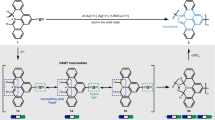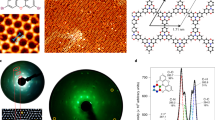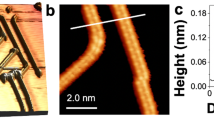Abstract
Polyacetylene (PA) comprises one-dimensional chains of sp2-hybridized carbon atoms that may take a cis or trans configuration. Owing to its simple chemical structure and exceptional electronic properties, PA is an ideal system to understand the nature of charge transport in conducting polymers. Here, we report the on-surface synthesis of both cis- and trans-PA chains and their atomic-scale characterization. The structure of individual PA chains was imaged by non-contact atomic force microscopy, which confirmed the formation of PA by resolving single chemical bond units. Angle-resolved photoemission spectroscopy suggests a semiconductor-to-metal transition through doping-induced suppression of the Peierls bond alternation of trans-PA on Cu(110). Electronically decoupled trans-PAs exhibit a band gap of 2.4 eV following copper oxide intercalation. Our study provides a platform for studying individual PA chains in real and reciprocal space, which may be further extended to study the intrinsic properties of non-linear excitons in conducting polymers.
This is a preview of subscription content, access via your institution
Access options
Access Nature and 54 other Nature Portfolio journals
Get Nature+, our best-value online-access subscription
$29.99 / 30 days
cancel any time
Subscribe to this journal
Receive 12 print issues and online access
$259.00 per year
only $21.58 per issue
Buy this article
- Purchase on Springer Link
- Instant access to full article PDF
Prices may be subject to local taxes which are calculated during checkout





Similar content being viewed by others
Data availability
The datasets generated and/or analysed during the current study are available from the corresponding author on reasonable request.
Code availability
The tight-binding calculations were performed using a custom-made code on the WaveMetrics IGOR Pro platform. Details of this tight-binding code can be obtained from the corresponding author on reasonable request.
References
Chiang, C. K. Electrical conductivity in doped polyacetylene. Phys. Rev. Lett. 39, 1098–1101 (1977).
Shirakawa, H., Louis, E. J., MacDiarmid, A. G., Chiang, C. K. & Heeger, A. J. Synthesis of electrically conducting organic polymers: halogen derivatives of polyacetylene, (CH)x. J. Chem. Soc. Chem. Commun. 578–580 (1977).
Hsu, S. L., Signorelli, A. J., Pez, G. P. & Baughman, R. H. Highly conducting iodine derivatives of polyacetylene: raman, XPS and X-ray diffraction studies. J. Chem. Phys. 69, 106–111 (1978).
Heeger, A. J. Nobel lecture: semiconducting and metallic polymers: the fourth generation of polymeric materials. Rev. Mod. Phys. 73, 681–700 (2001).
Chiang, C. K. et al. Conducting polymers: halogen doped polyacetylene. J. Chem. Phys. 69, 5098–5104 (1978).
Fincher, C. R. et al. Electronic structure of polyacetylene: optical and infrared studies of undoped semiconducting (CH)x and heavily doped metallic (CH)x. Phys. Rev. B 20, 1589–1602 (1979).
Park, Y.-W., Heeger, A. J., Druy, M. A. & MacDiarmid, A. G. Electrical transport in doped polyacetylene. J. Chem. Phys. 73, 946–957 (1980).
Ikehata, S. et al. Solitons in polyacetylene: magnetic susceptibility. Phys. Rev. Lett. 45, 1123–1126 (1980).
Harada, I., Furukawa, Y., Tasumi, M., Shirakawa, H. & Ikeda, S. Spectroscopic studies on doped polyacetylene and β‐carotene. J. Chem. Phys. 73, 4746–4757 (1980).
Ritsko, J. J. Core excitons in polyacetylene: evidence for a closed-gap metallic state. Phys. Rev. Lett. 46, 849–852 (1981).
Park, Y. W., Han, W. K., Choi, C. H. & Shirakawa, H. Metallic nature of heavily doped polyacetylene derivatives: thermopower. Phys. Rev. B 30, 5847–5851 (1984).
Park, Y. W. et al. Electrical conductivity of highly-oriented-polyacetylene. Solid State Commun. 65, 147–150 (1988).
Park, Y. W., Yoon, C. O., Na, B. C., Shirakawa, H. & Akagi, K. Metallic properties of transition metal halides doped polyacetylene: the soliton liquid state. Synth. Met. 41, 27–32 (1991).
Lavarda, F. C., Galvo, D. S. & Laks, B. Extended states in finite one-dimensional, disordered, highly doped, ItransR-polyacetylene chains. Phys. Rev. B 45, 3107–3110 (1992).
Shirakawa, H. The discovery of polyacetylene—the dawning of an era of conducting polymers. Curr. Appl. Phys. 1, 281–286 (2001).
Heeger, A. J. Semiconducting and metallic polymers: the fourth generation of polymeric materials. J. Phys. Chem. B 105, 8475–8491 (2001).
Su, W. P., Schrieffer, J. R. & Heeger, A. J. Solitons in polyacetylene. Phys. Rev. Lett. 42, 1698–1701 (1979).
Heeger, A. J., Kivelson, S., Schrieffer, J. R. & Su, W.-P. Solitons in conducting polymers. Rev. Mod. Phys. 60, 781–850 (1988).
Mele, E. J. & Rice, M. J. Semiconductor-metal transition in doped polyacetylene. Phys. Rev. B 23, 5397–5412 (1981).
Lavarda, F. C., dos Santos, M. C., Galvão, D. S. & Laks, B. Insulator-to-metal transition in polythiophene. Phys. Rev. B 49, 979–983 (1994).
Grill, L. et al. Nano-architectures by covalent assembly of molecular building blocks. Nat. Nanotechnol. 2, 687–691 (2007).
Zhong, D. et al. Linear alkane polymerization on a gold surface. Science 334, 213–216 (2011).
Cai, J. et al. Atomically precise bottom-up fabrication of graphene nanoribbons. Nature 466, 470–473 (2010).
Ruffieux, P. et al. On-surface synthesis of graphene nanoribbons with zigzag edge topology. Nature 531, 489–492 (2016).
Pavliček, N. et al. Synthesis and characterization of triangulene. Nat. Nanotechnol. 12, 308–311 (2017).
Zhang, Y.-Q. et al. Homo-coupling of terminal alkynes on a noble metal surface. Nat. Commun. 3, 1286 (2012).
Liu, J. et al. Lattice-directed formation of covalent and organometallic molecular wires by terminal alkynes on Ag surfaces. ACS Nano 9, 6305–6314 (2015).
Sun, Q. et al. Bottom-Up synthesis of metalated carbyne. J. Am. Chem. Soc. 138, 1106–1109 (2016).
Zhou, H. et al. Direct visualization of surface-assisted two-dimensional diyne polycyclotrimerization. J. Am. Chem. Soc. 136, 5567–5570 (2014).
Liu, J., Ruffieux, P., Feng, X., Müllen, K. & Fasel, R. Cyclotrimerization of arylalkynes on Au(111). Chem Commun. 50, 11200–11203 (2014).
Lomas, J. R., Baddeley, C. J., Tikhov, M. S. & Lambert, R. M. Ethyne cyclization to benzene over Cu(110). Langmuir 11, 3048–3053 (1995).
Gross, L., Mohn, F., Moll, N., Liljeroth, P. & Meyer, G. The chemical structure of a molecule resolved by atomic force microscopy. Science 325, 1110–1114 (2009).
Barborini, M. & Guidoni, L. Ground state geometries of polyacetylene chains from many-particle quantum mechanics. J. Chem. Theory Comput. 11, 4109–4118 (2015).
Natta, G., Mazzanti, G. & Corradini, P. in Stereoregular Polymers and Stereospecific Polymerizations 463–465 (Pergamon, 1967); https://doi.org/10.1016/B978-1-4831-9883-5.50084-2
Hudson, S. B. Polyacetylene: myth and reality. Materials 11, 242–261 (2018).
Chien, J. C. W., Warakomski, J. M., Karasz, F. E., Chia, W. L. & Lillya, C. P. Homogeneous doping and semiconductor-to-“metal” transition in polyacetylene. Phys. Rev. B 28, 6937–6952 (1983).
Dunlap, D. H., Wu, H.-L. & Phillips, P. W. Absence of localization in a random-dimer model. Phys. Rev. Lett. 65, 88–91 (1990).
Ferretti, A. et al. Ab initio complex band structure of conjugated polymers: effects of hydrid density functional theory and GW schemes. Phys. Rev. B 85, 235105 (2012).
Kresse, G. & Joubert, D. From ultrasoft pseudopotentials to the projector augmented-wave method. Phys. Rev. B 59, 1758–1775 (1999).
Blöchl, P. E. Projector augmented-wave method. Phys. Rev. B 50, 17953–17979 (1994).
Perdew, J. P., Burke, K. & Ernzerhof, M. Generalized gradient approximation made simple. Phys. Rev. Lett. 77, 3865–3868 (1996).
Grimme, S., Antony, J., Ehrlich, S. & Krieg, H. A consistent and accurate ab initio parametrization of density functional dispersion correction (DFT-D) for the 94 elements H-Pu. J. Chem. Phys. 132, 154104 (2010).
Acknowledgements
This work was supported by the Swiss National Science Foundation, the European Union’s Horizon 2020 research and innovation programme under grant agreement no. 785219 (Graphene Flagship Core 2), and the Office of Naval Research BRC programme. W.X. acknowledges financial support from the National Natural Science Foundation of China (grant nos. 21473123, 21622307, 21790351). S.W. acknowledges financial support from Thousand Young Talent Program and National Natural Science Foundation of China (grant nos. 11874258, 11790313). C.A.P. acknowledges the Swiss National Supercomputing Centre (CSCS) under project ID s746.
Author information
Authors and Affiliations
Contributions
W.X., R.F. and P.R. conceived the experiments. Q.S., S.W. and L.C performed the STM experiments. S.W., B.Y., C.L. and X.Y. performed nc-AFM and STS measurements. R.W., S.W. and O.G. performed the ARPES experiments. Q.S., O.G. and C.A.P. performed the calculations. H.J., Q.S., X.Y. and J.Z. performed the XPS experiments. S.W., Q.S., R.F. and W.X. wrote the paper. All authors discussed the results and implications and commented on the manuscript at all stages.
Corresponding authors
Ethics declarations
Competing interests
The authors declare no competing financial interests.
Additional information
Publisher’s note: Springer Nature remains neutral with regard to jurisdictional claims in published maps and institutional affiliations.
Supplementary information
Rights and permissions
About this article
Cite this article
Wang, S., Sun, Q., Gröning, O. et al. On-surface synthesis and characterization of individual polyacetylene chains. Nat. Chem. 11, 924–930 (2019). https://doi.org/10.1038/s41557-019-0316-8
Received:
Accepted:
Published:
Issue Date:
DOI: https://doi.org/10.1038/s41557-019-0316-8
This article is cited by
-
One-dimensional topological phase and tunable soliton states in atomic nanolines on Si(001) surface
npj Quantum Materials (2024)
-
The topological soliton in Peierls semimetal Sb
Scientific Reports (2024)
-
Real-space imaging of a phenyl group migration reaction on metal surfaces
Nature Communications (2023)
-
Visualization of on-surface polymerization
Science China Materials (2022)
-
From n-alkane to polyacetylene on Cu (110): Linkage modulation in chain growth
Science China Chemistry (2022)



